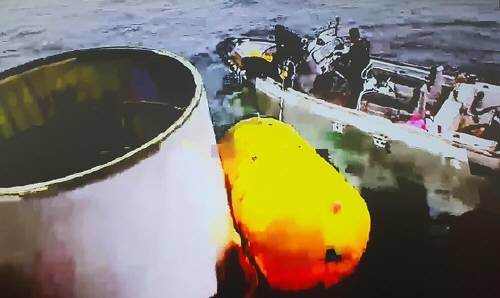South Korea and the United States have decided to jointly investigate after salvaging the second stage propellant of North Korea’s “Chollima-1” space launch vehicle (rocket) that crashed in the West Sea.
According to a Ministry of National Defense official on the 3rd, Defense Minister Lee Jong-seop met with U.S. Secretary of Defense Lloyd Austin at the 20th Asian Security Conference (Shangri-La Dialogue), which is being held at the Shangri-La Hotel in Singapore, and agreed on the above.
In December 2012, South Korea and the United States formed a joint investigation team to investigate the wreckage of North Korea’s long-range rocket Eunha 3, which was salvaged from the West Sea.
At that time, the Eunha 3 investigation was participated by strategic weapons experts from the Agency for Defense Development (ADD) on the Korean side and civilian experts who participated in the development of the Naro, and on the US side, experts who analyzed missiles developed by the former Soviet Union and Iran participated. .
 The Joint Chiefs of Staff announced on the 31st that the South Korean military identified and salvaged an object presumed to be part of a “space projectile” claimed by North Korea at around 8:05 am in the waters 200 km west of Eocheong Island in the West Sea. Provided by the Joint Chiefs of Staff
The Joint Chiefs of Staff announced on the 31st that the South Korean military identified and salvaged an object presumed to be part of a “space projectile” claimed by North Korea at around 8:05 am in the waters 200 km west of Eocheong Island in the West Sea. Provided by the Joint Chiefs of StaffOn the 31st of last month, North Korea launched a space projectile toward the south from Dongchang-ri, North Pyongan Province. The South Korean military found wreckage about 15m long in the area of the fall and is currently carrying out salvage operations.
On the afternoon of the 2nd, the South Korean military put the Cheonghaejin (ASR-21), a naval submarine rescue ship, into the area where the space launch vehicle fell to examine the situation. The Navy surface ship rescue ships ‘Tongyeong’ and ‘Gwangyang’ are also supporting the salvage work. From the morning of that day, deep-sea divers from the Marine Rescue Squadron (SSU) were dispatched from the sea about 200 kilometers west of Eocheong Island in Gunsan, North Jeolla Province.
Divers carry out the salvage work in groups of three using transfer capsules that supply oxygen for up to 72 hours. The remains of the second-stage projectile are estimated to be a two-stage propellant with a length of 15m and a diameter of 2-3m. It is said that it is difficult to salvage because of its large size and heavy weight.
Source: Donga
Mark Jones is a world traveler and journalist for News Rebeat. With a curious mind and a love of adventure, Mark brings a unique perspective to the latest global events and provides in-depth and thought-provoking coverage of the world at large.